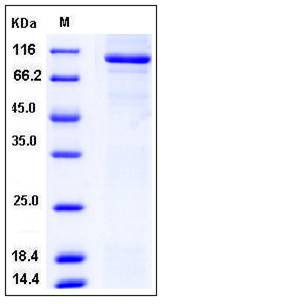Human STXBP3 / UNC-18C Protein (His & GST Tag)
MUNC18-3,MUNC18C,PSP,UNC-18C
- 100ug (NPP2524) Please inquiry
| Catalog Number | P11823-H20B |
|---|---|
| Organism Species | Human |
| Host | Baculovirus-Insect Cells |
| Synonyms | MUNC18-3,MUNC18C,PSP,UNC-18C |
| Molecular Weight | The recombinant human STXBP3/GST chimera consists of 829 amino acids and has a calculated molecular mass of 95.6 kDa as estimated in SDS-PAGE under reducing conditions. |
| predicted N | Met |
| SDS-PAGE |  |
| Purity | > 82 % as determined by SDS-PAGE |
| Protein Construction | A DNA sequence encoding the human STXBP3 (O00186-1) (Met 1-Glu 592) was fused with the N-terminal polyhistidine-tagged GST tag at the N-terminus. |
| Bio-activity | |
| Research Area | Cancer |Signal transduction |Protein Trafficking |Vesicle Transport |SNAPs & SNAREs |
| Formulation | Lyophilized from sterile 20mM Tris, 500mM NaCl, pH 8.5, 10% glycerol 1. Normally 5 % - 8 % trehalose, mannitol and 0.01% Tween80 are added as protectants before lyophilization. Specific concentrations are included in the hardcopy of COA. |
| Background | Syntaxin-binding protein 3, also known as Platelet Sec1 protein, Protein unc-18 homolog 3, Protein unc-18 homolog C, Unc-18C, Unc18-3 and STXBP3, is a cytoplasm protein which belongs to the STXBP/unc-18/SEC1 family. STXBP3 is expressed in cells that exhibit granule exocytosis, such as neutrophils, mast cells, platelets and endothelial cells. STXBP3, together with STX4 and VAMP2, may play a role in insulin-dependent movement of GLUT4 and in docking / fusion of intracellular GLUT4-containing vesicles with the cell surface in adipocytes. STXBP3 participates in the consolidation and secretion of secondary and tertiary granules. STXBP3 contains one SEC1 domain. Phosphorylation at Ser129 may stimulate granule release. Human STXBP3 shares 90% aa identity with mouse STXBP3. STXBP3 interacts with DOC2B; the interaction is direct, occurs at the cell membrane, excludes interaction with STX4 and regulates glucose-stimulated insulin secretion. Interacts with STX4. |
| Reference |
